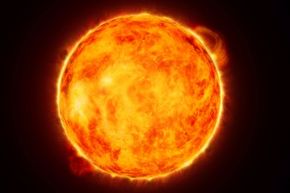The next time you're filling up your car's gas tank, take a moment to remember that fossil fuels are a finite resource. Eventually, humanity will need to satiate its hunger for energy from other sources.
The solution, perhaps, is in the stars. Or more accurately, our sun. Imagine filling your vehicle's tank not with gasoline, but with pure sunshine. In some distant future, this could happen thanks to the concept of a Dyson sphere.
Advertisement
Think of a Dyson sphere as a huge, energy-catching ball built around a star. It seizes solar energy and converts it into the kinds of energy that we can use to power vehicles, computers or whatever other advanced, power-sucking technologies we manage to develop in the next couple of million years. That is, of course, if we manage to survive that long without blowing everything up.
Dyson spheres are still very much in the imaginary stage of development. But it's not hard to see why we'd someday need greater, more powerful energy sources. We're burning fossil fuels at ever-increasing rates in order to operate all manner of gadgets and goods. Sustainable energy sources, such as solar and wind power, are good for supplementing coal and petroleum, but right now they can't power all of our cars and smartphones.
Fantastical Dyson spheres have become a staple of science fiction books and TV shows and Internet forums. "Star Trek" junkies debate the relative possibilities (or ridiculousness) of trying to encapsulate an entire star with a manmade machine. Blog-loving scientists lay bare ideas for making real these gigantic spheres; others pick apart their aspirations with stinging comments.
No matter what you think of the idea, one thing is for sure: When the taps finally run dry on oil, and eventually they will, humankind will either need to scale back on its energy usage or find new power sources. Maybe a Dyson sphere is the way.
Advertisement




